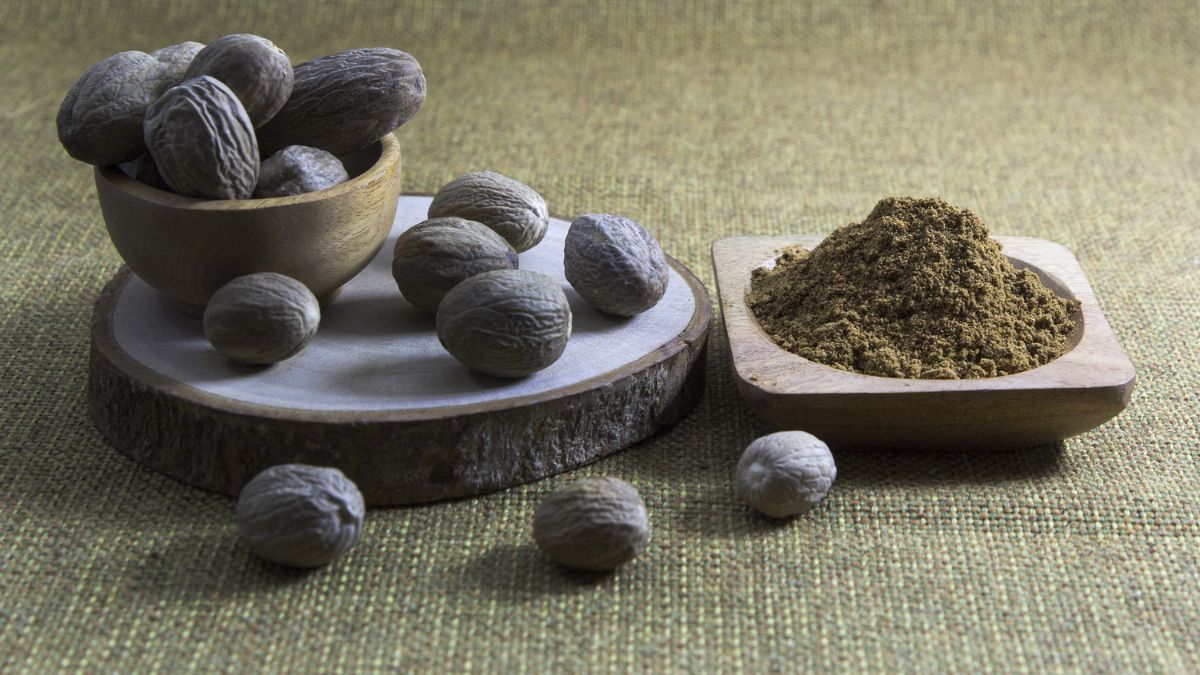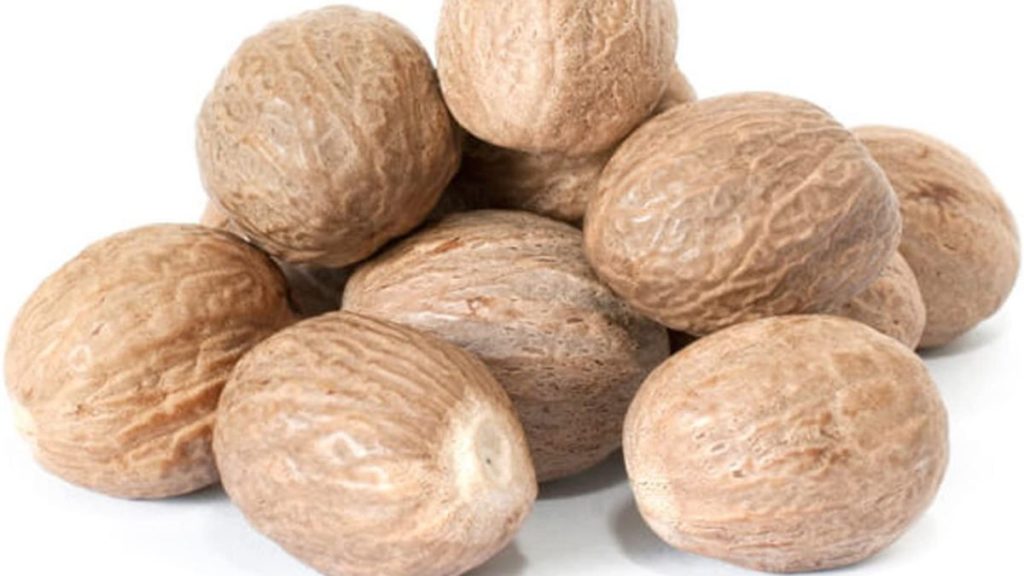Nutmeg is a spice with a pungent aroma and a warm, slightly sweet flavour that is used to flavour baked products, confections, puddings, potatoes, meats, sausages, and sauces, vegetables, and beverages like eggnog. The spice mace is made from the fleshy arils that surround the nutmeg seed.
Nutmeg is a spice derived from the seeds of the nutmeg tree (Myristica fragrant), an evergreen tree native to Indonesia that produces two prominent spices: Nutmeg and mace. Nutmeg’s interior seed and the scarlet, lace-like stuff that covers it is mace. Nutmeg is a classic autumn spice found in various desserts and beverages. It’s also delicious in savoury meals like butternut squash soup and goes well with cream or cheese-based dishes like vegetable gratin.
What is Nutmeg?
Nutmeg is a spice prepared from the inner section of the seed within the apricot-sized fruit of the nutmeg plant. It’s made from the seed of the nutmeg tree (Myristica fragrans), an evergreen species native to Indonesia’s spice islands, the Maluku Islands. The interior nutmeg seeds are sun-dried for six to eight weeks after the fruit splits open before being sold whole or processed into a fine powder. The whole Nutmeg has an ovular shape and a dark brown, wrinkled surface and is often under 1 inch long.
To manufacture Nutmeg for flavouring, the nutmeg seeds are progressively dried in the sun for six to eight weeks. The Nutmeg shrinks away from its hard seed covering during this time. When the kernels rattle in their shells when shaken, the spice is ready. It is sold whole or crushed up and packaged after being separated from the outer coat (mace).
Nutmeg has a long and fascinating history, reaching back to the first century A.D. The Dutch conquest of the Banda Islands culminated in slaughter to monopolize the nutmeg trade, a prized spice regarded as a high currency for commerce. As a result, the Dutch East India Company was formed, a merger of many Dutch trading businesses.
Nutmeg vs. Mace
Even though both spices come from the same tree, Nutmeg and mace are not the same. The outer covering of the nutmeg seed, known as mace, is removed first and ground into a red-coloured spice, while the nutmeg pit or seed can be left whole or ground up. Nutmeg has a softer flavour than mace and is sweeter and more delicate; a mace is hotter and tastes like a cross between pepper and cinnamon. Even though they grow together, they are rarely combined in a dish.
The Myristica fragrans tree produces a variety of aromatic spices. A red-orange aril (or seed covering) encases the nutmeg seed before being ready for culinary use. This is removed, crushed flat, and dried to make mace, a spice with a flavour comparable to Nutmeg but more intense and hotter, like cinnamon or black pepper. It’s available whole or ground, much like Nutmeg. Mace is not as widely used or as simple as Nutmeg, but if you have it, you may substitute it for Nutmeg in most recipes; use half the amount asked for, as mace has a stronger flavour.
What does it Taste Like?
Nutmeg is an aromatic spice with a strong and distinct aroma that is nutty and slightly sweet. Nutmeg may appear spicy to folks who are more sensitive to heat. Nutmeg is a popular spice that comes in both ground and whole forms. It has a toasty, nutty flavour with both sweet and savoury foods. Nutmeg spice has a toasty, fragrant flavour with clove undertones after ground. Nutmeg has a woody, bittersweet flavour with traces of clove and a fresh, rich scent. It has a rich flavour and is warm and aromatic.
Whole vs. Ground
Nutmeg is available in two forms: whole seed and ground in a container. Using freshly grated Nutmeg instead of store-bought ground nutmeg gives a fresher, cleaner flavour. In its complete form, Nutmeg is about the size of an apricot pit and has a long shelf life. However, pre-ground Nutmeg has a shorter shelf life.
Nutmeg has a nutty, toasty, and somewhat sweet flavour, whether whole or ground. It has clove and tobacco undertones, as well as lemony undertones. If you buy the seeds whole and shred them fresh for the dish, you’ll get the richest, most intense flavour; however, you’ll need a fine grater, nutmeg rasp, or pepper mill. Hold the seed firmly and wipe it across the grater or rasp to zest a lemon or grated Parmesan cheese.
How to Cook with Culinary Nutmeg?
Although store-bought powdered nutmeg powder is the most convenient way to use this spice, freshly ground Nutmeg from the whole seed is the most aromatic and fragrant. Shred a small quantity into your dish with a nutmeg grater, pepper mill, or Microplane to cook with the whole Nutmeg. Nutmeg is also a good match for creamy sauces and cheesy meals like bechamel, alfredo sauce, and soufflés, which benefit from the spice’s mild spiciness.
Nutmeg is a spice with a rich culinary history that may be used in sweet and savoury dishes. It can be grated whole and immediately into a recipe or measured or shaken from a pre-ground nutmeg canister. Shave off a small seed piece with a Microplane or nutmeg grater to use the whole Nutmeg. When using Nutmeg, be careful not to use too much, as this powerful spice can quickly overshadow a dish’s characteristics. Nutmeg can be found in various spice blends, including pumpkin pie spice, ras el hanout, and garam masala. It’s also used to flavour and decorate some hot beverages, such as cappuccino and eggnog.
How to Find Nutmeg?
This aromatic spice is most recognized in the United States as a baking spice used in fall-friendly pumpkin and apple pies and an ingredient in sweet, warming beverages such as chai tea, mulled wine, and eggnog. Nutmeg is also a good match for creamy sauces and cheesy meals like bechamel, alfredo sauce, and soufflés, which benefit from the spice’s mild spiciness.
Nutmeg is a common component to warm soups and stews in Indonesia, such as oxtail soup and beef stew, and it’s also used in meat rubs for meals like Indonesian pork Bostik. Nutmeg is used to create numerous Indian meats and sweet desserts and in savoury spice blends like garam masala and curry powder.
While Nutmeg is traditionally used to make Mortadella sausages and fill stuffed kinds of pasta in Italy, it is also used to make the savoury meat pudding haggis in Scotland. Nutmeg is coupled with potato dishes and robust vegetables like cauliflower and brussels sprouts in Dutch cuisine. Nutmeg is a prominent component in ras el hanout and jerk flavours in Middle Eastern and Caribbean cuisines.
How to Store Nutmeg?
Keep ground nutmeg away from heat, light, and moisture in an airtight container. Ground nutmeg will keep its freshness for around six months if stored correctly. Nutmeg in the whole form will keep indefinitely but keep it away from heat and moisture. If you only use Nutmeg occasionally, buying the whole Nutmeg is the ideal alternative because it will deliver fresh, fragrant, and tasty spice each time it is grated.
Nutmeg, in any form, should be stored in an airtight container. If stored in the open air, whole and ground Nutmeg will lose flavour and become worthless; however, an airtight container can considerably prevent flavour loss. Because of its larger surface area, the degradation process for ground nutmeg will be faster. When Nutmeg comes into contact with air, it oxidizes, and the volatile oils that give it its flavour and scent evaporate.
5 Common Spice Blends Featuring Nutmeg
Pumpkin Pie Spice – Cinnamon, Nutmeg, cloves, and ginger are a warm, sweet, and spicy mixture that is a prominent ingredient in pumpkin pie and other fall treats.
Quatre-Epices – ground pepper, Nutmeg, cloves, and ginger make up this French condiment, which means “four spices.” Both French and Middle Eastern cuisines use this combination.
Advieh – Dried rose petals, Nutmeg, cinnamon, cloves, cardamom, turmeric, and cumin are commonly used in this delicious Persian spice blend. This mixture is commonly used in stews and rice dishes in Persian cuisine.
Jerk Seasoning -Cayenne pepper, chiles, Nutmeg, dried thyme, garlic, and cinnamon make up this spicy, flavour-packed spice blend native to Grenada. To give meat and vegetable dishes a Caribbean flavour, sprinkle it on top.
Ras el Hanout – Cumin, cardamom, cinnamon, ginger, nutmeg, aniseed, cloves, and turmeric make up this classic Moroccan spice blend.
What are the Health Benefits of Nutmeg?
Nutmeg is high in antioxidants, fibre, vitamins A and C, and minerals like manganese, zinc, and iron, and when ingested in moderation, it provides several health benefits. Nutmeg is said to have some health benefits, including enhanced brain and heart health, reduced inflammation, and improved digestive health. Nutmeg can aid with nausea, diarrhea, appetite suppression, and achy pain.
Nutmeg can also aid in managing blood sugar, reduce blood clotting, lower blood pressure, and absorb more calcium into the body because of its high manganese content.
Dental Health: Several dental products use nutmeg oil. The spice possesses antibacterial qualities that are very efficient against germs that cause disease and foul breath in the mouth.
Improved Mood: Nutmeg was discovered to be a possible antidepressant in male rats in one study, and the spice has long been utilized in folk medicine for its energizing effects.
Better Sleep: Nutmeg has been demonstrated to improve the duration and quality of sleep, and human studies of better quality are needed to confirm this impact.
6 Nutmeg Recipe Ideas
- Pumpkin Pie – Pumpkin purée, evaporated milk, eggs, sugar, grated nutmeg, cinnamon, and cloves are all included in this traditional pie recipe.
- Butternut Squash Soup -Squash, chicken stock, butter, sliced onion, Nutmeg, and black pepper are blended into a creamy puréed butternut squash soup.
- Moroccan Lamb Tagine – Traditional Moroccan lamb stew with tomato sauce, sliced onions, and a spice blend of Nutmeg, cumin, coriander, star anise, turmeric, and cardamom served in a tagine pot.
- Candied Pecans with Nutmeg baked in the oven, then dipped in egg whites and dusted with cinnamon, Nutmeg, white sugar, and salt.
- Jerk Chicken -Quartered chickens rubbed with a puréed paste of onion, chile, garlic, pepper, Nutmeg, thyme, salt, and pepper and grilled until done.
- Vanilla and Nutmeg Rice Pudding – Jasmine rice, heavy cream, milk, sugar, entire vanilla bean, and freshly grated Nutmeg make this rice pudding.
Conclusion
Nutmeg is the dried, pulverized seed of the Myristica fragrans tree, which is used as a spice in anything from baked foods to sausage spices, braised leafy greens pots to eggnog jugs. The Myristica fragrans tree is a tropical evergreen native to Indonesia. Still, it may be found in various tropical climates, including Grenada in the Caribbean, Sri Lanka, Guatemala, and Kerala in southern India, to name a few. Nutmeg is a versatile spice used in sweet and savoury dishes and is frequently done. It can be purchased whole, grated finely into dishes using a Microplane or a special nutmeg grater (also known as a nutmeg rasp), or ground for a more accessible, quick pinch.


